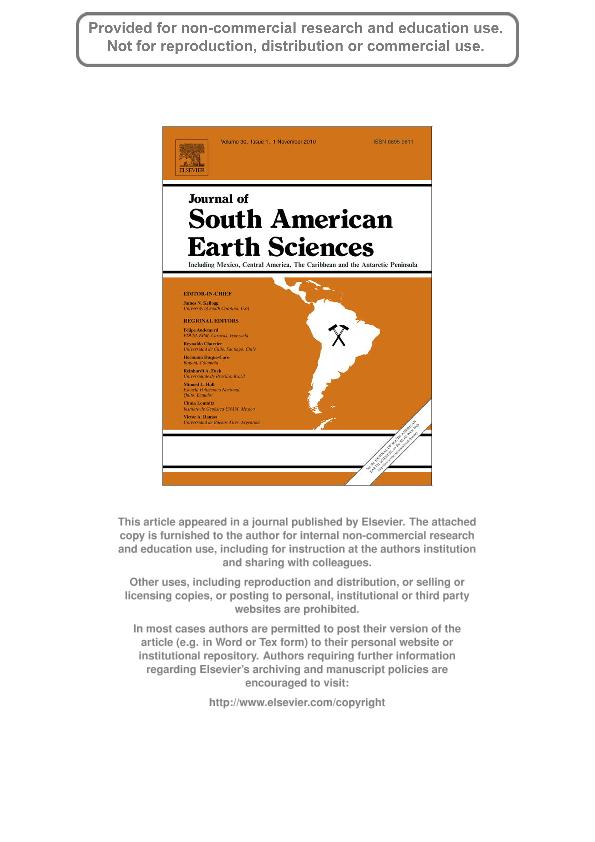Mostrar el registro sencillo del ítem
dc.contributor.author
Martino, Roberto Donato

dc.contributor.author
Guereschi, Alina Beatriz

dc.contributor.author
Anzil, Patricia Andrea

dc.date.available
2018-08-08T14:48:52Z
dc.date.issued
2010-11
dc.identifier.citation
Martino, Roberto Donato; Guereschi, Alina Beatriz; Anzil, Patricia Andrea; Metamorphic and tectonic evolution at 31°36′S across a deep crustal zone from the Sierra Chica of Córdoba, Sierras Pampeanas, Argentina; Pergamon-Elsevier Science Ltd; Journal of South American Earth Sciences; 30; 1; 11-2010; 12-28
dc.identifier.issn
0895-9811
dc.identifier.uri
http://hdl.handle.net/11336/54547
dc.description.abstract
A geological section at 31°36′S cut the main structures of a representative area of the deep crust in the Sierra Chica (Sierras Pampeanas of Córdoba, Argentina), where associations of high-grade gneisses, migmatites, marbles, amphibolites and ultramafic rocks are recognized. A group of ultramafic bodies composed of serpentinized spinel harzburgites are associated with a basement affected by a M2-D2 regional metamorphism that developed the main S2 metamorphic foliation. Applying different thermobarometers to the varieties of garnet sillimanite gneisses and leucocratic garnet gneisses, a range of P-T conditions of 768-840 °C and 7.3-8.6 kb were obtained for M2. A strong D3 ductile deformation structured the ultramafic bodies, more viscous than the associated metamorphic rocks, generating large west-vergent sheath folds with tubular geometry. This constrictional deformation was developed in a simple shear regime, under high-temperature conditions, with a tectonic transport direction toward the northwest (~N 300°). Later, decompression and cooling down to amphibolite facies conditions occurred in all the rocks of the area during a retrograde M3 event. A range of P-T conditions of 588-710 °C and 5.2-7.3 kb were calculated for M3 in the gneisses of the area. The Sierra Chica ultramafic rocks outcrop as folded bodies, isolated between them and locally parallel to the S2 metamorphic foliation, therefore they cannot be correlated as a regional belt that could be interpreted as an ancient suture. Our hypothesis is that the ultramafic bodies are upper mantle relics of earlier emplacements into an accretionary prism that was entirely reworked during the Pampean orogeny. This same outcrop-pattern can also be recognized in the other ultramafic bodies in the Sierras de Córdoba. Hence, we suggest to avoid the use of the terms Eastern and Western Belts for the treatment of the ultramafic rocks in the Sierras de Córdoba. © 2010 Elsevier Ltd.
dc.format
application/pdf
dc.language.iso
eng
dc.publisher
Pergamon-Elsevier Science Ltd

dc.rights
info:eu-repo/semantics/openAccess
dc.rights.uri
https://creativecommons.org/licenses/by-nc-sa/2.5/ar/
dc.subject
High-Grade Gneisses
dc.subject
Metamorphism
dc.subject
Sierras Pampeanas
dc.subject
Structure
dc.subject
Tectonic Evolution
dc.subject
Ultramafic Rocks
dc.subject.classification
Meteorología y Ciencias Atmosféricas

dc.subject.classification
Ciencias de la Tierra y relacionadas con el Medio Ambiente

dc.subject.classification
CIENCIAS NATURALES Y EXACTAS

dc.title
Metamorphic and tectonic evolution at 31°36′S across a deep crustal zone from the Sierra Chica of Córdoba, Sierras Pampeanas, Argentina
dc.type
info:eu-repo/semantics/article
dc.type
info:ar-repo/semantics/artículo
dc.type
info:eu-repo/semantics/publishedVersion
dc.date.updated
2018-08-02T14:50:10Z
dc.journal.volume
30
dc.journal.number
1
dc.journal.pagination
12-28
dc.journal.pais
Países Bajos

dc.journal.ciudad
Amsterdam
dc.description.fil
Fil: Martino, Roberto Donato. Consejo Nacional de Investigaciones Científicas y Técnicas. Centro Científico Tecnológico Conicet - Córdoba. Centro de Investigaciones en Ciencias de la Tierra. Universidad Nacional de Córdoba. Facultad de Ciencias Exactas Físicas y Naturales. Centro de Investigaciones en Ciencias de la Tierra; Argentina
dc.description.fil
Fil: Guereschi, Alina Beatriz. Consejo Nacional de Investigaciones Científicas y Técnicas. Centro Científico Tecnológico Conicet - Córdoba. Centro de Investigaciones en Ciencias de la Tierra. Universidad Nacional de Córdoba. Facultad de Ciencias Exactas Físicas y Naturales. Centro de Investigaciones en Ciencias de la Tierra; Argentina
dc.description.fil
Fil: Anzil, Patricia Andrea. Consejo Nacional de Investigaciones Científicas y Técnicas. Centro Científico Tecnológico Conicet - Córdoba. Centro de Investigaciones en Ciencias de la Tierra. Universidad Nacional de Córdoba. Facultad de Ciencias Exactas Físicas y Naturales. Centro de Investigaciones en Ciencias de la Tierra; Argentina
dc.journal.title
Journal of South American Earth Sciences

dc.relation.alternativeid
info:eu-repo/semantics/altIdentifier/url/https://www.sciencedirect.com/science/article/pii/S0895981110000428
dc.relation.alternativeid
info:eu-repo/semantics/altIdentifier/doi/http://dx.doi.org/10.1016/j.jsames.2010.07.008
Archivos asociados
